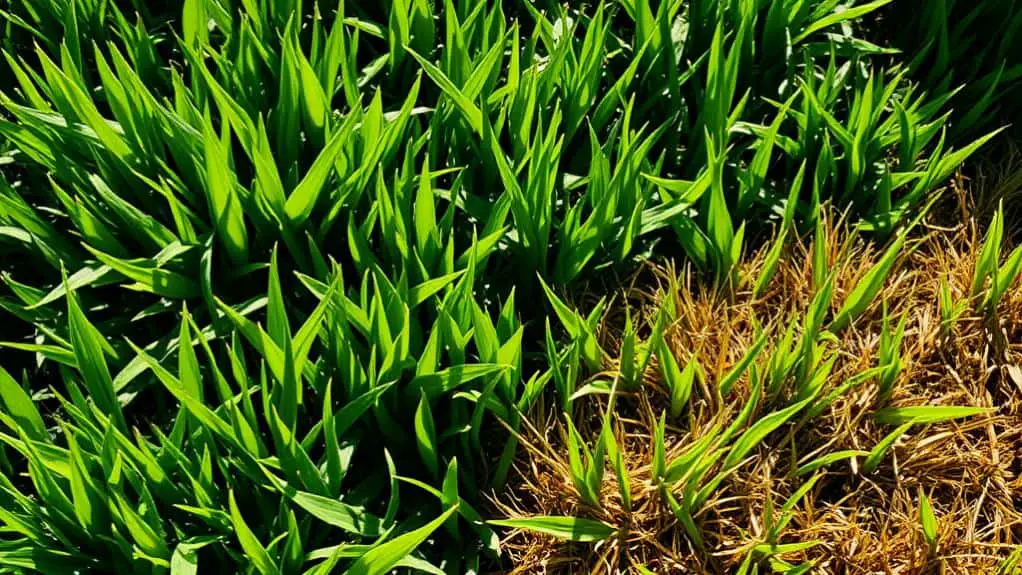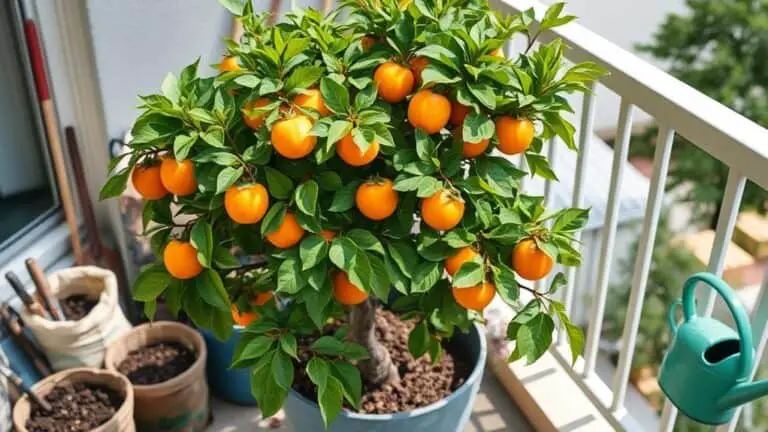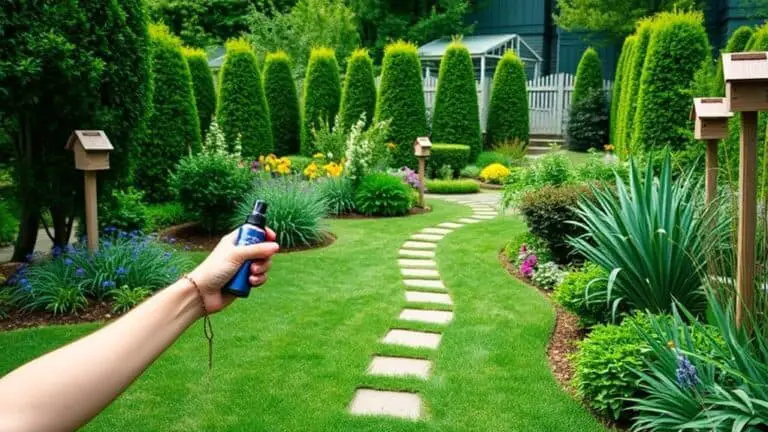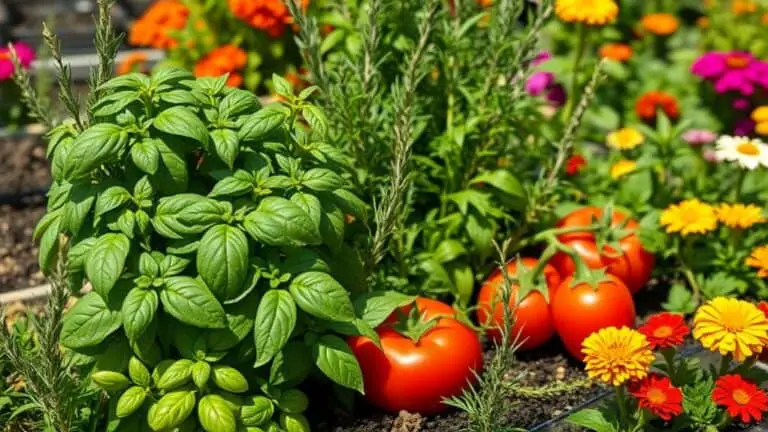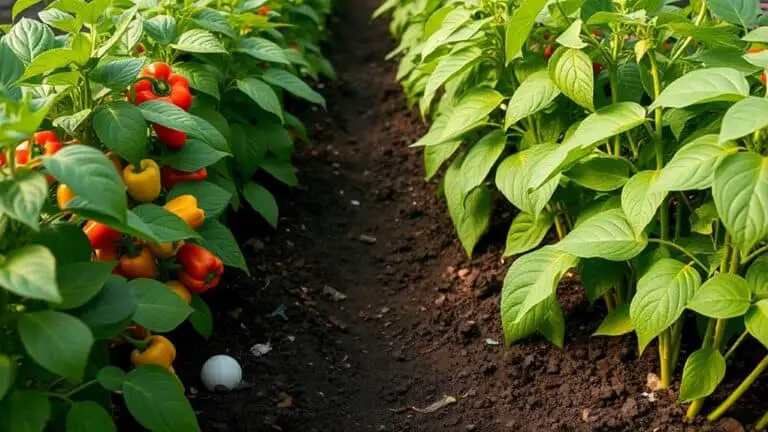Does Watering Grass In The Sun Burn It
I've often wondered if watering grass in the sun could actually burn it, and it turns out many folks believe so. However, scientific studies suggest otherwise. The idea that water droplets act like tiny magnifying glasses scorching the blades is largely a myth. While there are better times of day to water your lawn to avoid evaporation, the notion of burning grass this way is not founded in science. So, what's the best approach to guarantee your lawn stays lush and green without falling for common misconceptions? Let's explore the facts and best practices next.
Myth of Midday Watering
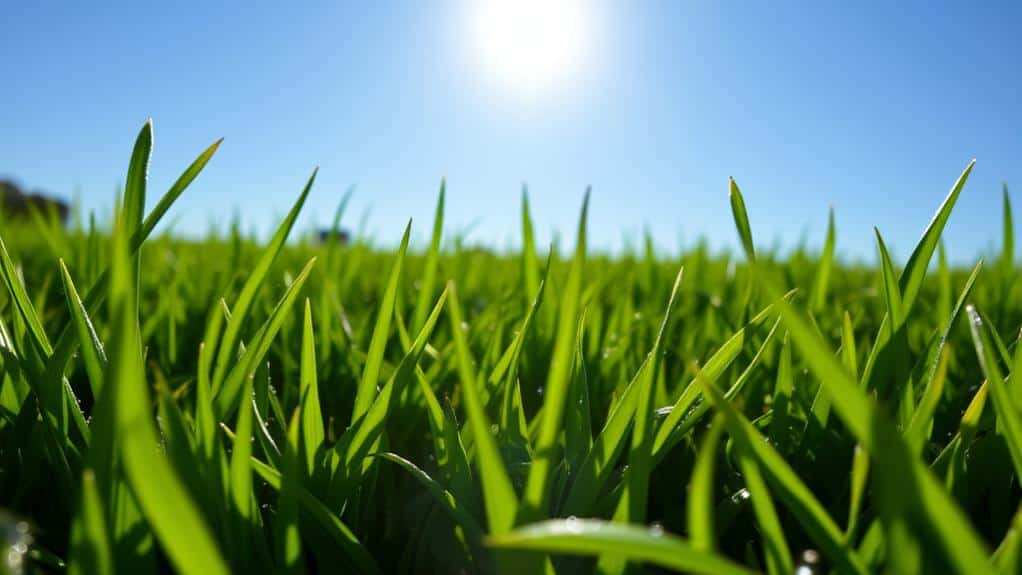
Contrary to popular belief, watering your grass in the heat of midday won't scorch it. Many people think that droplets of water on grass blades act like tiny magnifying glasses, causing sun burn.
However, scientific studies show this just isn't true. Watering at midday doesn't harm your grass; the effect of magnified sunlight is too minimal to cause any real damage.
In fact, proper watering is much more important for your lawn's health than worrying about the time of day. High temperatures and drought stress are the real culprits behind leaf scorch, not midday watering.
Effects of Water Stress
Water stress often manifests in your lawn as wilting or discoloration, signaling an urgent need for hydration to prevent irreversible damage.
If you delay watering during extreme heat, the grass can suffer terminal wilt, meaning it's past saving. Misinterpreting symptoms like leaf burn might lead you to incorrect conclusions about your watering habits.
Instead, consider environmental factors or drought stress. High light exposure and temperature extremes can worsen water stress, especially for sensitive grass types.
Regularly monitoring soil moisture is essential because grass roots need enough hydration to withstand heat and drought.
Understanding Leaf Scorch
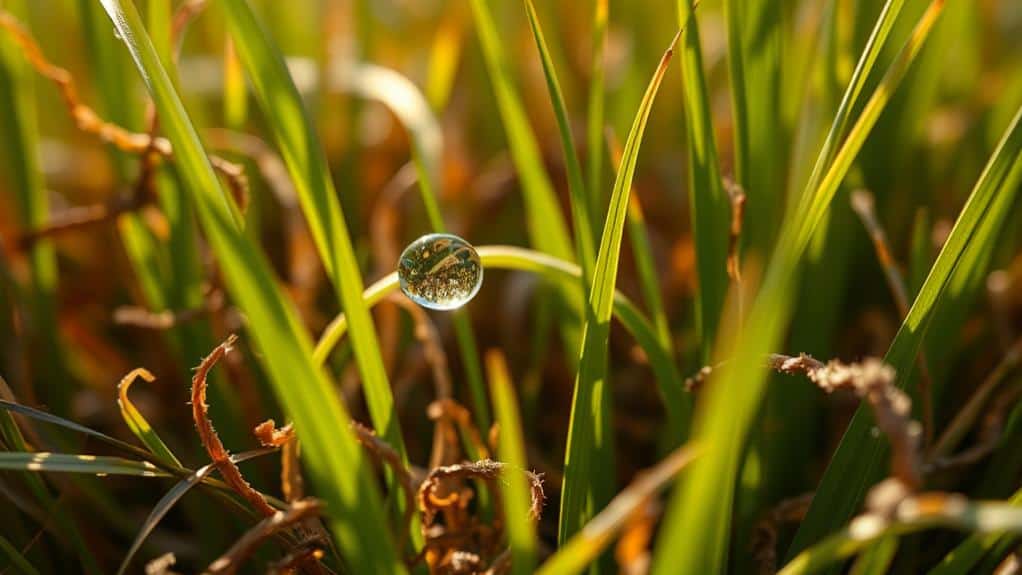
In the domain of lawn care, understanding leaf scorch is essential for maintaining a healthy and vibrant yard. Leaf scorch is that dreaded condition where the leaf margins turn brown and wilt. It's often due to environmental stress, like extreme sun and high temperatures.
Even if you water regularly, intense sunlight and heat can still damage your grass, especially if it's not accustomed to such conditions.
Monitoring your lawn is vital. By catching early signs of stress, you can prevent the irreversible damage leaf scorch might cause.
Remember, it's not just about watering. Factors like soil moisture, temperature fluctuations, and proper plant placement play significant roles in keeping your yard lush and green.
Best Practices for Watering
When it comes to keeping your lawn green and healthy, knowing the best practices for watering is crucial.
One key tip is to water deeply and infrequently. Aim for 0.25 to 0.50 inches every 3 to 4 days. This helps develop strong root systems, making your lawn more drought-resistant.
Check the soil moisture to decide when to water; it should be dry 2-3 inches deep. A soil moisture meter can help with this.
Also, avoid watering in the evening to reduce the risk of fungal diseases. Morning watering is best for absorption and minimizes evaporation.
Follow these practices to guarantee a lush, healthy lawn that's both resilient and beautiful.
Optimal Watering Times

Understanding the best practices for watering sets the stage for choosing the ideal times to do so. From my experience, the best watering times are early morning and late afternoon. During these cooler parts of the day, grass absorbs water more effectively, reducing evaporation and wastage. Morning watering, between 6:00 AM and 9:00 AM, is especially beneficial, as it prepares the lawn for the summer heat. On the other hand, watering in the evening (6:00 PM to 9:00 PM) might seem convenient, but it can promote fungal diseases due to prolonged leaf wetness.
| Time of Day | Effectiveness |
|---|---|
| Early Morning | High absorption, low evaporation |
| Afternoon | High evaporation, low absorption |
| Evening | Risk of fungal diseases |
Soil Moisture Monitoring
When it comes to knowing the best time to water your grass, checking soil moisture is essential.
I recommend using a soil moisture meter to see if the soil is dry down to about 2-3 inches, which helps avoid overwatering and keeps your grass healthy.
If you find the soil is still slightly damp, hold off on watering to prevent root suffocation and promote strong, deep roots.
Importance of Soil Testing
Have you ever wondered why your grass isn't thriving despite regular watering? The answer might lie in the soil itself.
Soil testing is vital because it reveals nutrient levels and pH, which directly influence moisture retention. If your soil lacks the right nutrients or has an improper pH, it can't hold moisture effectively, causing your grass to suffer.
Regular soil moisture monitoring is essential to determine the appropriate watering needs. It helps prevent overwatering or underwatering, which can harm grass health.
High-quality, moisture-retaining soil can lengthen the intervals between watering, promoting healthier root systems.
Using Moisture Meters
Using moisture meters is a game-changer for anyone serious about lawn care. These handy tools give accurate readings of soil moisture levels, helping you make better decisions when watering your lawn. By checking the moisture every few days, you can avoid overwatering or underwatering, keeping your grass healthy. Soil moisture meters show dryness at depths of 2-3 inches, essential for root health. Plus, if you have high-quality, moisture-retaining soil, you can extend watering intervals, making these meters vital for efficient water management. They also let you adjust watering schedules based on grass type and seasonal changes, boosting lawn resilience.
Here's a quick table to help you understand the benefits:
| Benefit | Description |
|---|---|
| Accurate Readings | Measures moisture at various depths |
| Prevents Over/Underwatering | Regular checks maintain ideal grass health |
| Indicates When to Water | Shows dryness at critical root depth |
| Efficient Water Management | Extends watering intervals with good soil |
Optimal Watering Depth
Understanding the ideal watering depth for your lawn is essential for maintaining its health and resilience. When you water your lawn, aim for the soil to be moist 2-3 inches deep. This depth guarantees your lawn gets the right amount of hydration.
Using a soil moisture meter can help you determine when it's time to water. Deep watering promotes strong root growth, making your lawn more robust. On the other hand, shallow watering can lead to weak roots and more water evaporation.
Quality soil that retains moisture well means you won't need to water as often, saving water. Monitoring soil moisture helps avoid overwatering, which can suffocate roots and damage your grass.
Keep your lawn healthy by watering wisely!
Watering Frequency and Depth
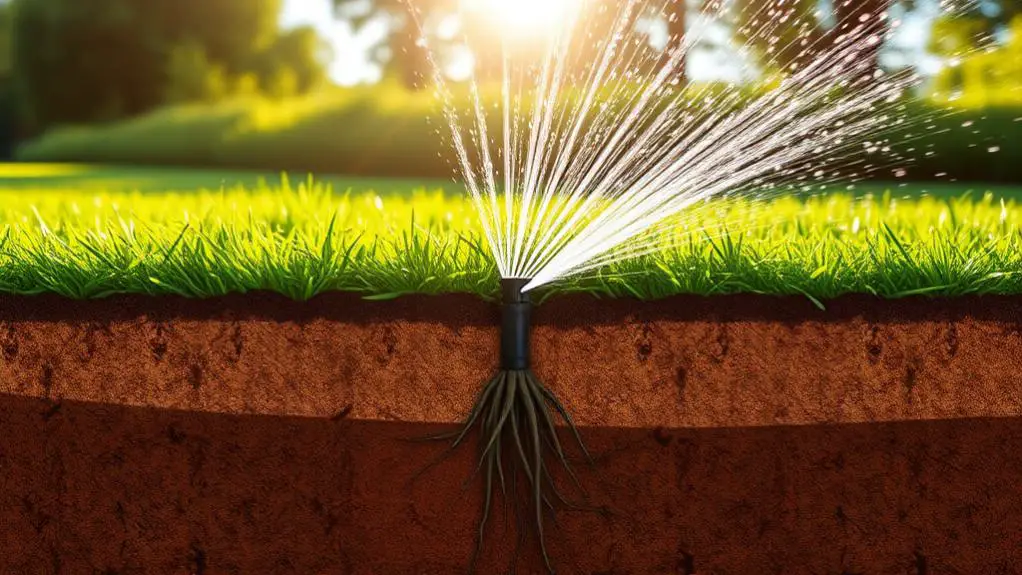
Let's talk about how often and how deeply we should water our lawns to keep them healthy.
Frequent, shallow watering might seem convenient, but it actually weakens the grass roots, making them more prone to drought.
Instead, aim for deeper watering sessions every few days to encourage strong roots that can reach down for nutrients and moisture, keeping your lawn resilient and lush.
Optimal Watering Depth
Making certain your lawn gets the right amount of water at the proper depth is essential for its health and resilience. Striking the balance for best watering depth and water distribution can make all the difference. Here are some tips to help you achieve this:
- Deep watering: Water to a depth of 6-8 inches to encourage robust root systems.
- Watering frequency: Apply 0.25 to 0.50 inches of water every 3-4 days, adjusting for weather and grass type.
- Seasonal adjustments: Modify your schedule based on seasonal changes to maintain ideal moisture levels.
- Soil moisture meter: Use one to check moisture levels, making certain you water only when necessary.
These practices make certain your lawn stays lush and resilient.
Encouraging Deep Roots
Maintaining the right watering depth is just one part of the equation; encouraging deep roots is equally important for a healthy lawn.
When you water grass deeply, it encourages roots to grow deeper into the soil, making the grass more resilient to drought and stress. Aim for longer watering sessions, delivering about 0.25 to 0.50 inches of water every 3 to 4 days. This helps the roots access moisture and nutrients more effectively.
Remember to adjust your watering schedule with the seasons; cooler months require less frequent watering to avoid over-saturation.
Healthy, deep roots not only enhance drought resilience but also reduce the need for frequent irrigation, ensuring a vibrant lawn year-round.
Avoiding Shallow Watering
Too often, frequent, shallow watering does more harm than good. It encourages weak root systems, making your grass more vulnerable to drought stress and heat damage.
Instead, aim for deep watering which allows moisture to penetrate the soil to a depth of 6-8 inches. Here's how to guarantee you're watering less but more effectively:
- Water infrequently but deeply: Aim for 1 to 1.5 inches of water per week.
- Adjust for seasons and grass types: Tailor your watering schedule to match these changes.
- Use a soil moisture meter: Check soil dryness to a depth of 2-3 inches before watering.
- Promote healthy root growth: This enhances drought resilience and overall lawn health.
Grass Type Watering Needs
Understanding the specific watering needs of your grass type is essential for a lush and healthy lawn.
Cool-season grasses, like Fescue and Kentucky Bluegrass, need about 1 inch of water weekly to stay vibrant.
Warm-season grasses, such as Couch and Buffalo, are more drought-tolerant and typically require 0.5 to 1 inch of water every week during their active growth period.
It's vital to monitor soil moisture levels, adjusting your watering based on environmental conditions to optimize lawn health.
During hot summer weather, even drought-tolerant grasses might need extra water droplets to prevent stress.
Importance of Soil Health
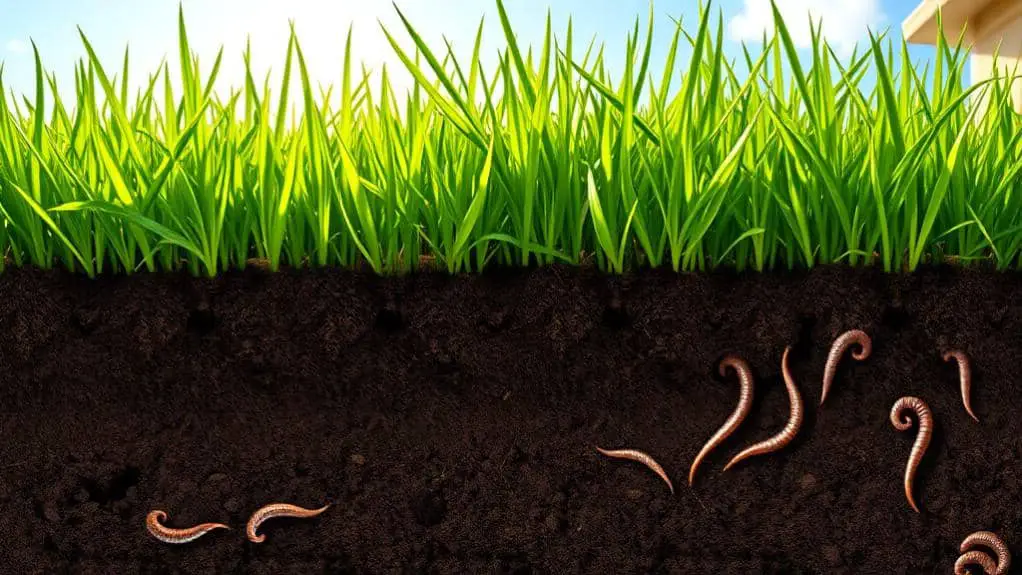
While we often focus on watering schedules and mowing techniques, the foundation of a truly healthy lawn lies in the soil.
Soil health is essential for moisture retention, which keeps your grass lush and green, especially during hot, dry spells.
Here are some practical tips to improve your soil health:
- Aerate regularly: This helps water penetrate deeply and promotes root development.
- Add organic matter: Compost and other organic materials improve soil structure and increase its capacity to retain moisture.
- Test your soil: Regular soil testing helps you understand pH and nutrient levels, so you can make necessary adjustments.
- Mulch grass clippings: This simple practice reduces evaporation and keeps the soil moist.
Investing in soil health guarantees your lawn thrives!
Common Lawn Care Misconceptions
Let's clear up some common lawn care misconceptions, especially about watering during the day.
Many people believe that watering grass in direct sunlight will burn it, but research shows that grass can handle daytime watering just fine.
The real key to a healthy lawn is proper watering techniques, like giving your grass deep, infrequent drinks to strengthen its roots.
Daytime Watering Myths
Contrary to popular belief, watering your lawn during the day doesn't scorch the grass. I've dived into this topic, and it's time to bust this myth.
Here are some key points to evaluate:
- Watering grass in hot weather: Research shows no significant harm to grass from daytime watering practices.
- Water droplets acting as magnifying glasses: While this can happen, the effect is minimal and doesn't lead to significant leaf scorch.
- Evaporation concerns: Watering during peak sun hours may lead to more evaporation, but it doesn't directly damage the grass.
- Optimal watering times: Early morning or evening are ideal since cooler periods enhance water absorption and reduce waste.
Proper Watering Techniques
Proper watering techniques are vital for maintaining a healthy, vibrant lawn.
Let's clear up a common misconception: watering grass during the day doesn't burn it. Instead, focus on ideal watering times. The best time to water your lawn is early morning when temperatures are cooler. This reduces evaporation and helps water reach the roots more effectively.
Using the right watering tools, like sprinklers or soaker hoses, guarantees even distribution. Deep, infrequent watering encourages stronger root systems, making your grass more drought-tolerant.
Regularly monitor soil moisture to avoid overwatering. Also, understanding the specific needs of your grass type is important.
Frequently Asked Questions
Is It Bad to Water Grass When It's Hot?
It's not bad to water grass when it's hot. The water temperature effects are minor, but proper watering techniques matter. Early morning is best to reduce evaporation and guarantee your grass absorbs enough moisture to stay healthy.
When Should You Not Water Your Lawn?
You shouldn't water your lawn between 10 AM and 4 PM due to increased evaporation. Also, avoid evening watering to prevent fungal diseases. Use proper watering techniques for effective lawn care, and always check soil moisture first.
Does Grass Burn From the Sun?
Grass doesn't get sunburn from the sun alone. Lawn health depends on proper watering and care. High temperatures can stress grass, but adequate hydration and attention to soil moisture levels play a more critical role.
Is It Okay to Water Grass Seed in the Sun?
Yes, it's okay to water grass seed in the sun. I've found that consistent moisture is key for grass growth. While early morning is best, midday watering doesn't harm. Different watering techniques guarantee soil stays moist for ideal germination.
Conclusion
So, don't worry about watering your grass in the sun—it won't burn it! The idea that midday watering harms your lawn is just a myth. Instead, focus on deep watering to keep your grass healthy and vibrant. Remember, different grass types have unique needs, so get to know your lawn. With the right techniques and a bit of care, you can maintain a lush, green yard all summer long. Happy watering!

